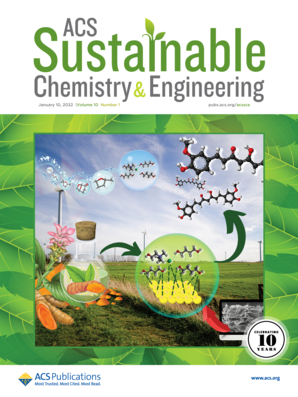静电纺丝使PET水解酶嵌入高熔点PET微纤维中成为可能
IF 7.1
1区 化学
Q1 CHEMISTRY, MULTIDISCIPLINARY
引用次数: 0
摘要
聚乙烯对苯二甲酸乙二醇酯(PET)的全球年产量为2550万吨,需要可持续的回收和废物处理战略来解决日益严重的塑料污染问题。通过挤压将酶直接嵌入聚合物是一种新兴的生物降解方法。然而,PET的高熔融温度(Tm)(260°C)以前限制了这种策略,因为没有报道的PET水解酶可以忍受这样的条件。另外,静电纺丝是基于聚合物溶解而不是熔融加工,是一种很有前途的方法,可以将耐溶剂酶嵌入具有高Tm的聚合物中。本研究通过静电纺丝将PET水解酶LCC-ICCG (ICCG)包埋在PET微纤维中。ICCG沿静电纺微纤维二维平面(2D平面)均匀分布,主要分布在表面相关的纤维层中。在672小时内,包埋ICCG催化的PET微纤维水解产生了85.64 mM的单芳香产物(质量损失10.7±0.3%),尽管生物催化剂暴露于溶剂溶液中会降低活性。静电纺丝使PET的非晶态含量从56.15%提高到72.44%,同时保持了超细纤维的弹性。负载iccg的PET微纤维的机械强度下降了26.29%,证实了纤维的有效降解。本文章由计算机程序翻译,如有差异,请以英文原文为准。
Electrospinning Enables Embedding of PET Hydrolases in High-Melting PET Microfibers
Polyethylene terephthalate (PET) is produced globally at 25.5 million metric tons annually, necessitating sustainable recycling and waste treatment strategies to address increasing plastic pollution. Embedding enzymes directly within polymers by extrusion is an emerging biological degradation approach. However, the high melting temperature (Tm) of PET (260 °C) has previously limited this strategy since no reported PET hydrolase can tolerate such conditions. Alternatively, electrospinning is based on polymer dissolution rather than melt processing and is a promising approach to embed solvent-tolerant enzymes into polymers with high Tm. Here, we embedded the PET hydrolase LCC-ICCG (ICCG) in PET microfibers via electrospinning. ICCG was distributed homogeneously along the two-dimensional plane (2D plane) of electrospun microfibers and was primarily localized in surface-associated fiber layers. Over 672 h, hydrolysis of PET microfibers catalyzed by embedded ICCG yielded 85.64 mM of mono-aromatic products (10.7 ± 0.3% mass loss), despite activity reduction by exposure of the biocatalyst to the solvent solution. Electrospinning increased the amorphous content of PET from 56.15% to 72.44%, while preserving microfiber elasticity. Mechanical strength decreased by 26.29% in ICCG-loaded PET microfibers, which confirmed effective fiber degradation.
求助全文
通过发布文献求助,成功后即可免费获取论文全文。
去求助
来源期刊

ACS Sustainable Chemistry & Engineering
CHEMISTRY, MULTIDISCIPLINARY-ENGINEERING, CHEMICAL
CiteScore
13.80
自引率
4.80%
发文量
1470
审稿时长
1.7 months
期刊介绍:
ACS Sustainable Chemistry & Engineering is a prestigious weekly peer-reviewed scientific journal published by the American Chemical Society. Dedicated to advancing the principles of green chemistry and green engineering, it covers a wide array of research topics including green chemistry, green engineering, biomass, alternative energy, and life cycle assessment.
The journal welcomes submissions in various formats, including Letters, Articles, Features, and Perspectives (Reviews), that address the challenges of sustainability in the chemical enterprise and contribute to the advancement of sustainable practices. Join us in shaping the future of sustainable chemistry and engineering.
 求助内容:
求助内容: 应助结果提醒方式:
应助结果提醒方式:


